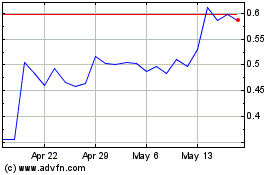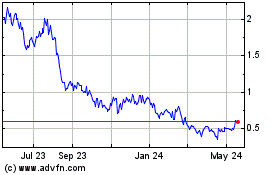23andMe Holding Co. (Nasdaq: ME), a leading human genetics company
with a mission to help people access, understand, and benefit from
the human genome, today released a new polygenic risk score (PRS)
report* on the genetics of osteoporosis for 23andMe+ Premium
members. The report informs customers if they are at a higher
likelihood of developing osteoporosis based on a statistical model
developed by 23andMe through its proprietary research database,
along with actionable lifestyle factors that can reduce their risk.
Osteoporosis is a condition in which bone density becomes too
low, which makes bones more fragile and prone to breaks
(fractures). It's estimated that 12.3 million Americans have
osteoporosis, and an additional 40+ million have osteopenia (a less
severe form of low bone density).
Osteoporosis becomes more common with age, and women are more
likely to develop the condition than men. Other risk factors
include having a family history of the condition, having a small
body frame, taking certain medications (such as corticosteroids),
and having certain other health conditions. Often called a "silent"
disease, osteoporosis usually has no symptoms until people break a
bone — most commonly in the spine, hip, or wrist and often as a
result of minor falls or normal activities.
If diagnosed early, osteoporosis is highly actionable. There are
medications that can help slow bone loss, and strategies that can
help prevent falls. Importantly, healthy lifestyle habits such as
exercise, diet and avoiding smoking and heavy alcohol consumption
can help lower one’s risk of developing the condition. Despite its
actionability and health impacts, osteoporosis is often
underdiagnosed and undertreated. According to the International
Osteoporosis Foundation, about half of women and up to a quarter of
men in the U.S. will break a bone due to low bone density, but ~80%
of these individuals are never tested or treated for
osteoporosis.
“Predominantly diagnosed in women, there are around 2 million
new osteoporosis-related fractures in the U.S. each year, which is
more than the number of new cases of heart attacks, breast cancer,
and prostate cancer combined,” said Dr. Noura Abul-Husn, MD, PhD,
Vice President of Genomic Health at 23andMe. “We’re proud to
continue our commitment to developing genetic reports that impact
women’s health, adding osteoporosis to our existing slate of
offerings that include breast cancer, gestational diabetes,
polycystic ovary syndrome (PCOS), uterine fibroids, among
others.”
23andMe’s Osteoporosis PRS report* is based on a statistical
model developed by 23andMe through its proprietary research
database. The report takes into account an individual’s genetic
results at many genetic markers, along with their genetic ancestry
and birth sex to estimate the likelihood of developing
osteoporosis. According to published data, it's estimated that
genetics explains ~60-80% of the variability in bone density.
The Osteoporosis PRS report was developed by 23andMe scientists
and clinical experts using 23andMe’s database of genetic and health
information contributed by consented research participants. A
published white paper provides full details on the science and
methodology behind 23andMe’s PRS technology.
While 23andMe's new report provides an estimate of one's
likelihood of developing osteoporosis, it does not account for
every possible genetic variant that could impact a person’s
likelihood of developing the condition, nor does it account for
non-genetic factors. To learn more about the new Osteoporosis PRS
report and how to become a 23andMe+ Premium member, visit
https://www.23andme.com/membership/.
About 23andMe23andMe is a genetics-led consumer
healthcare and research company empowering a healthier future. For
more information, please visit investors.23andme.com.
Forward-Looking StatementsThis press release
contains forward-looking statements within the meaning of Section
27A of the Securities Act of 1933, as amended, and Section 21E of
the Securities Exchange Act of 1934, as amended, including. All
statements, other than statements of historical fact, included or
incorporated in this press release are forward-looking statements.
The words "believes," "anticipates," "estimates," "plans,"
"expects," "intends," "may," "could," "should," "potential,"
"likely," "projects," “predicts,” "continue," "will," “schedule,”
and "would" or, in each case, their negative or other variations or
comparable terminology, are intended to identify forward-looking
statements, although not all forward-looking statements contain
these identifying words. These forward-looking statements are
predictions based on 23andMe’s current expectations and projections
about future events and various assumptions. 23andMe cannot
guarantee that it will actually achieve the plans, intentions, or
expectations disclosed in its forward-looking statements and you
should not place undue reliance on 23andMe’s forward-looking
statements. These forward-looking statements involve a number of
risks, uncertainties (many of which are beyond the control of
23andMe), or other assumptions that may cause actual results or
performance to differ materially from those expressed or implied by
these forward-looking statements. The forward-looking statements
contained herein are also subject generally to other risks and
uncertainties that are described from time to time in the Company’s
filings with the Securities and Exchange Commission, including
under Item 1A, “Risk Factors” in the Company’s most recent Annual
Report on Form 10-K, as filed with the Securities and Exchange
Commission, and as revised and updated by our Quarterly Reports on
Form 10-Q and Current Reports on Form 8-K. The statements made
herein are made as of the date of this press release and, except as
may be required by law, 23andMe undertakes no obligation to update
them, whether as a result of new information, developments, or
otherwise.
Contact
Informationpress@23andme.cominvestors@23andme.com
*The 23andMe PRS reports are based on genetic models that
include data from 23andMe consented research participants and
incorporate thousands of genetic variants to describe if a person
has a certain likelihood of developing a condition, but do not
describe a person’s overall likelihood. The PRS reports do not
account for lifestyle or family history and have not been reviewed
by the US Food and Drug Administration. The PRS reports are not
intended to tell you anything about your current state of health,
or to be used to make medical decisions or determine any
treatment.
23andMe (NASDAQ:ME)
Historical Stock Chart
From Feb 2025 to Mar 2025

23andMe (NASDAQ:ME)
Historical Stock Chart
From Mar 2024 to Mar 2025
